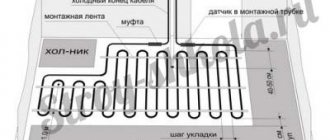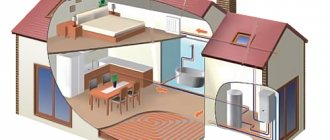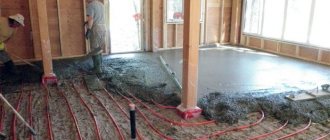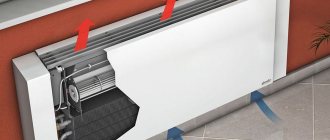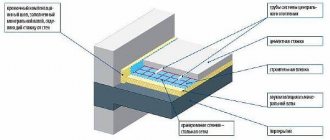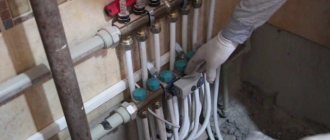Heating system without thermostat
Many people are interested in whether it is possible to connect a heated floor directly without a thermostat. Experts say this could, in theory, be done by connecting the system to a regular switch. However, you will have to constantly monitor the temperature in the room to prevent overheating and damage to the equipment. It also consumes too much electricity, so this method is inconvenient and unprofitable.
Without a thermostat, the heater runs constantly, raising the room temperature to maximum and consuming unnecessary energy. When the sensors operate, only those resources that are necessary to achieve the recommended temperature are extracted and consumed. Heated floors without a regulator can be connected, but only for a short time, so that there is no network overload and overheating of the floor covering with subsequent damage.
Connecting a heated floor without a thermostat can lead to fires, so it is recommended to buy temperature controllers. However, temperature sensors don't have to be everywhere. These may be limited to specific rooms and circuits that require lower temperatures. Infrared mats can themselves control the necessary system parameters, so a warm floor without a thermostat is a possible option for a heating system.
Reason 1: Discomfort
The temperature of the carbon film at the peak of heating is +60°C, therefore, the floor covering will warm up to at least 45-50°C. Agree that walking on such a floor will not be very comfortable.
You can connect a heated floor to the light switch and manually turn it on and off when the temperature becomes comfortable, but then you will have to constantly be on duty at the switch, and then it’s easier to install a thermostat and “forget”.
After all, if a heated floor is connected directly to an outlet, then the electricity consumption will be constant, unlike a heated floor with a regulator that will be “on-off”. warm floor and save electricity.
Temperature control
Thermostats for underfloor heating systems are available in many versions, ranging from a simple controller with a small wheel for manually setting the room temperature to a complex mini-computer with digital display and touch screen. There are also devices that are designed for a single room and thermostats that are used to regulate the temperature throughout the entire building at all times.
Many owners do not connect heated floors without a temperature sensor, even if this applies to electric mats, where self-regulation is possible. To control the temperature, thermostats are installed, which, using a built-in sensor, measure the actual value and adjust it according to the specified target parameters.
When choosing a model, you need to consider the installation location of the device. It should not be constantly exposed to direct sunlight or heat sources, as this will affect the temperature sensors. In addition, the thermostat should be placed so that it is always accessible and there is sufficient air circulation.
Reason 3: Damage to the floor covering
When using a heated floor without a thermostat, the temperature of the floor covering, as we mentioned in the first reason, will be 45-50°C.
In the end, the conclusion is disappointing:
If you have any questions, call and our specialists will answer everything in detail.
August 03, 2021, Articles
It is important not only to feel comfortable when stepping on a heated floor, which should not be too hot or cold due to low heating.
Installing the Thermostat
Before installation, it is necessary to draw a sketch, where the location of the sensor should be planned at a distance of at least 50 cm from windows and doors and only on internal walls. Up to three heating mats can be connected to the device.
If a room's electric underfloor heating system requires more than three heating mats, calculate several thermostats accordingly. The sensor must be between two heating cables, use the existing power connections to connect the power cord.
During installation, you need to perform the following steps step by step:
- In the pre-drilled groove in the wall and floor, install the thermostat and heating mat cables.
- Then place the temperature sensor between them (the curvature of the line must have a radius of at least 6 cm).
- After cleaning the surface, it is recommended to prime the ceiling for better adhesion.
- After laying, press the mats firmly to the base for optimal fixation, and attach the thermostat to the contacts.
- Then you need to fill the space with screed.
Before screeding and finishing work, you need to check the resistance with a multimeter. Before turning on the thermostat, you need to wait 8-10 days until the screed is completely dry.
Design features and functionality
Is it possible to connect a heated floor without a thermostat? Even if someone says that it is possible, an experienced master will answer no. The thermostat is an important component of the design.
There are several objective reasons why installing a thermostat is considered necessary:
Operating a heated floor without a regulator will lead to overload of the heating element
The quality of room heating depends on what system is installed to provide it and what floor covering is laid on top.
The thermostat ensures optimal and precise control of cable systems designed for heating and heating applications. It is able to protect both the floor covering and the heated floor system itself from damage.
If laminate, carpet or linoleum is laid on the floor, the continuous flow of heat will lead to rapid failure of the floor covering and its rapid replacement. The laminate will begin to dry out, the seams and joints will separate and cracks will appear.
In addition, the thermostat will ensure that the system turns on only at the right time and turns off after the room has fully warmed up. This device will allow the owner not to manually adjust the heating level and not constantly choose the most economically advantageous hours to turn on the system. With the help of a thermostat, the temperature in the room where it is installed will be maintained at one constant level. This will have a positive effect on the created microclimate and will allow you to feel coziness and comfort.
Carbon heated floor installation
Electric heated floor technology
Installation of a mixer for a warm water floor
Calculator for calculating the cost of heating mats and their sets with thermostats:
area, sq.m 0.5 0.6 1 1.5 2 2.5 3 4 5 6 7 8 10 12
- 1
- 2
- 3
- 4
- 5
- 1
- 2
- 3
- 4
- 5
© 2007 — 2021 www.thermo-plus.ru official dealer of Thermo Industri AB
Electric heated floors require the installation of a thermostat. This device is needed to maintain a stable set temperature in the room. The thermostat turns the floors off and on according to the temperature sensor readings.
Connecting a heated floor is possible without using a thermostat. However, in this case, you will have to manually organize the operating mode of the system. Firstly, it is inconvenient; secondly, home owners are deprived of the following benefits:
When choosing a thermostat, you need to take into account the power consumption of the floor heating system. Typically, devices with a power of 3 kV are used. The device can be connected directly to the panel or through an outlet. The device is always accompanied by instructions in what order to connect the power wires, as well as ground, phase and neutral.
Connection via socket
Connection via panel
Connecting a heated floor without using a thermostat
How to choose a thermostat for a heated floor
Normal operation of a heated floor is impossible without a thermostat, which allows you to save a significant amount of energy and money. When performing the assigned tasks, this device only turns the heating on and off at a set period of time or in accordance with the readings of the thermometer. When choosing a thermostat, it is necessary to take into account its power, which must correspond to the power of the heated floor.
The creation of the most comfortable conditions in the room, as well as the safety of the floor covering, largely depends on the operation of the thermostat. If the temperature is too high, the floor covering may become deformed, crack and lose its quality. Therefore, which thermostat is best to choose for a heated floor is an important issue when installing heating systems.
Among the huge number of models and designs of thermostats, experts distinguish several main groups:
- Devices that provide an economical mode of operation, allowing to reduce energy consumption in the absence of owners. At this time, the heating power decreases by several degrees.
- Models with a programmable timer that allows you to set any time intervals during which the room will be heated at a given intensity. All commands from the timer are transmitted to the thermostat, which, in turn, maintains the required temperature level.
- There are highly intelligent designs where entire operating modes can be programmed and set, in which periods of heating and saving alternate. The command from the device goes directly to the heating element at a set time, depending on external factors and specified settings.
- Thermostats using a built-in limiter, which is a special sensor that protects the floor covering and the heating element itself from overheating. Such devices are most effective, which should not heat above 260C. Otherwise, the release of harmful toxic substances will begin.
The choice of thermostat for a particular room depends on its area. For a small room, a regular device without programming or installation will be sufficient. The use of more complex programmable devices is best suited for larger spaces. Most often in such cases they are used with temperature sensors installed inside the floor.
How to connect a heated floor to a thermostat
When installing an electric heated floor, the most important and complex process is connecting it to the power supply system. Even a beginner can handle the installation of all the elements of heated floors, but if you make a mistake in the connection, then all the work can go to waste, because there is a risk of failure of the entire system or “breakdowns” of electricity due to improperly organized grounding.
To prevent this from happening, it is better to contact specialists from teplyidom86.ru.
Benefits of having a thermostat
The electric underfloor heating system contains temperature sensors, the main function of which is to collect information about the state of the floor temperature. In order for the process to be controlled automatically, special thermostats are installed that independently turn off the system or activate it, guided by data on the temperature in the room.
Of course, a heated floor can be connected to the network without auxiliary devices that regulate its operation. Then you will have to set the heating mode manually, which is extremely inconvenient, depriving yourself of the following advantages:
- the room temperature is kept at the set level automatically;
- it is possible to start heating at a certain time;
- 24-hour comfortable temperature control;
- energy saving.
The choice of thermostatic device depends on the power consumption of the heated floor. There are two options for connecting it: through an outlet and directly to the panel.
The instructions for each device always contain a clear connection diagram for power wires, phase, neutral and grounding.
Connecting the thermostat to the outlet
This connection option is the most common and is performed in the following sequence:
- Installing the thermostat on the wall, making grooves for the device.
- From the socket, the phase and neutral wires, grounding, are brought to the distribution box.
- The floor heating cable and the wire from the temperature sensor are laid in the groove leading to the thermostat.
- According to the instructions for the device, connect the wires according to the diagram.
- Connect the floor system to the thermostat.
Connection directly to the panel
This type of connection is used when the thermostat will regulate the temperature of a large room (more than 20 sq.m). According to this method, the phase, neutral and ground wires are connected identically, as in the case of a socket. The difference lies in the need to install a residual current device in the electrical panel.
stroybud.com
Connecting the thermostat. How to connect a heated floor to a thermostat
Connecting underfloor heating is the most popular method of additional heating of a room. To save money, it is permissible to do some of the work yourself
In the presented material we will consider how to connect a heated floor to existing heating systems and what subtleties are important to take into account.
Two fundamental types of thermal floors have been implemented - water heated floors and electric ones. In water-based heating, the coolant is heated water supplied from the boiler or a common riser.
And in electric floors, heat transfer is implemented as follows: the flowing current heats the copper heating elements, and they, in turn, transfer heat to surrounding objects. Electric mats and heating cables operate on this principle. And the principle of operation of infrared film lies in the emission of long infrared waves by specialized elements, which warm up all objects in the room.
Any of the types has subtleties when connecting, then we will consider the connection of heated floors in more detail.
Types of heated floors
Preparation of the base and connection of heated floors
Before connecting the heated floor, it is necessary to make preparations. Whatever floor heating scheme you choose for implementation, it is always important to prepare the base:
- The first step is to dismantle the old floor covering.
- If a new screed is to be made, then it is also necessary to remove the old screed.
- Then the base is inspected and if cracks and deep chips are found, they are repaired. To do this, the crack is cleared to a solid base, the surface is primed and filled with a manufactured solution or a specially purchased repair mixture.
- The next step is to lay a waterproofing layer in the form of a polyethylene film with a minimum thickness of 200 micrometers.
- Then the thermal insulation layer is laid, and a damper film is attached to the walls along the perimeter of the room, which will level out the thermal expansion of the future screed.
The algorithm for preparing the base is the same for almost all types of heated floors, with the exception of infrared heated floors.
Connecting a water floor
The most competent answer to how to connect water-based heated floors is to connect them to a boiler using a water pump. Due to the fact that the coolant temperature cannot be more than 35 degrees, it is necessary to use collectors and mixing units.
To ensure such a connection, three-way and two-way valves are installed. Then the supply pipe is connected to the distribution board, which should have outputs according to the number of circuits, as well as flow regulators and valves. Using them you can regulate the water supply and adjust the temperature of the entire floor.
To require shutting off a separate supply and return circuit, taps are installed.
Approximate diagram of connecting a water floor
Connecting a thermostat to a heated floor
Before answering the question of how to connect a heated floor to a thermostat, you need to study what a regulator is and how it is connected to the circuit.
The main task of this device is to regulate the temperature in the room. The heating elements are also connected to the power supply through the thermostat.
The thermostat, which monitors the air temperature in the room, is mounted on the wall at a distance of at least one meter from the floor level.
There are two main ways to connect a thermostat. This is the connection to the department
piorit.ru
- How to lay tiles on gvl
- Differences between single-core and double-core underfloor heating
- Self-leveling floor unis consumption
- How many meters of pipe are needed for 1 square meter of heated floor
- How to make a floor in a house from timber
- Which varnish is best for the floor
- What's on the floor
- What to put on the bathroom floor instead of tiles
- Warm light floor
- What floor to make in the kitchen in the apartment
Heated floor installation
The heating cable/heating film, thermostat and temperature sensor are the main elements of a heated floor, the functioning of which may be impaired.
How does the "warm floor" system work?
- Electric current is supplied through the heating cable, heating the conductor, then the heat flows through the insulating sheath to the concrete screed/floor covering and is distributed further.
- The main function of the thermostat is to compare the temperature set by the user with the ambient temperature: if it is lower, the corresponding elements are activated and the floor is heated.
- A temperature sensor is a resistor whose resistance is directly proportional to temperature. In case of any malfunction of the system, a preliminary check must be performed to help ensure that the heated floor temperature sensor has broken down.
Rules for installing a thermostat
Thermostat for heated floors
It is necessary to connect electrical cables and wiring from temperature sensors to the thermostat hung on the wall. To do this, appropriate grooves are made in the slab - grooves. In them, wires are laid to the electrical panel and to the floor.
The floor temperature sensor must be as far from each other as possible from adjacent heating elements, otherwise when they are turned on, it will immediately trigger and disconnect the electrical circuit
If the equipment is installed in a room with high-quality interior finishing, then you can use overhead devices and run cables over the walls in boxes.
The following are the basic rules that must be observed when installing thermostats:
- It is better to place the adjusting device at a distance of 40-170 cm from the floor, unless otherwise provided in the instructions. If you have a mobile control panel, the main box can be installed in any convenient place.
- The main functions of the floor temperature sensor are to prevent overheating of the floor covering and foot comfort, but not to control the temperature of the air in the room.
- In damp rooms, it is permissible to use thermostats with appropriate protection against water ingress.
- When the device is built into a wall, a mounting box made of non-combustible materials is used.
- Wires from the regulator to underfloor heating heaters with a power of more than 1 kW must be routed in hollow heat-resistant tubes.
- The floor temperature sensor should be located between the heating elements and at least 50 cm from the walls.
- When turning on the device for the first time, it is necessary to take into account the minimum operating temperature specified in the instructions.
- Wire connections to the thermostat terminals must be made exclusively according to the diagram specified in the manual.
- Installation of the thermostat begins only after the heating elements are finally laid on the floor in order to correctly calculate the length of the wires.
- When filling the floor with solution, it is necessary to well insulate the end of the tube with the temperature sensor.
- Before pouring the solution onto the floor, it is necessary to check the functionality of all elements of the system.
- Heating mats must be grounded, and an RCD is installed in front of the thermostat.
Compliance with these rules will protect residents from electric shock, the house from fire, and equipment from premature failure.
